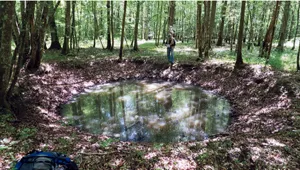
Of Forests and Foxholes
Dave Passmore hunts for Second World War foxholes the way children hunt for Easter eggs: with enthusiasm and determination.
He’s also interested in finding bunkers, supply depots and any other evidence the European landscape will yield about strategy, preparations and battles during the Second World War. Passmore, a PhD and sessional lecturer in physical geography at U of T Mississauga, is passionate about conflict archeology, a growing field that combines an understanding of the physical features of a landscape and its history, especially as it was used during wartime.
“My work in conflict archeology grew out of a personal interest in military history and the Second World War and an academic background in geography and archeology,” Passmore says.
As a child growing up in England, Passmore was fascinated by the war, an event that had an enormous impact on the landscape and its people, and afterward dictated the economic and political climate in Britain. His fascination has continued and overlapped with his career.
“I’m interested in the human impact on the landscape and how that landscape affects human activity,” Passmore says.
In the aftermath of the war, however, much of the physical evidence in Europe disappeared quickly. Cities were rebuilt and agricultural land was replanted. However, many forests were largely untouched, leaving a rich source of information that Passmore and his colleagues are exploring. They are amongst the first to take up this challenge.
“The study of Second World War archeology is relatively new,” he says. “To date, most of the attention has focused on the First World War, but with the passage of time and as the veterans of the Second World War begin to leave us, there should be more interest.”
Forests Rich in History
Passmore and his colleagues saw it as an opportunity to explore uncharted territory. They did their initial work in the Ardennes Forest, site of the Battle of the Bulge, where the landscape was full of evidence of ground combat. The forest, which straddles the borders of France, Belgium, Luxembourg and Germany, is pockmarked by shell craters, earthen bunkers and foxholes that Passmore and colleagues have documented.
“In forests, you can walk around foxholes and bunkers and stand next to shell craters and get a sense of how battle unfolded and how soldiers saw the terrain,” Passmore says.
They have since turned their attention to the Normandy region of France, site of the Normandy invasion that led to the end of the war in Western Europe. This area has yielded up a rich network of German logistics depots and bomb craters.
Passmore noted that the initial goal is to discover and map these wartime remnants, using archival documents along with LIDAR, a radar-based remote sensing system. He and his colleagues want to document them before they are lost.
“We’re blending a ground archeological survey with quite an extensive search of the war archives,” he says. “We’ve accessed the German archives and determined where they built their depots, but we’re also interested in what the Allies knew using intelligence from Ultra code decryptions, aerial reconnaissance, the French Resistance fighters and air crews that crashed. This gives us a much richer picture of what went on.”
A Call to Action
Once the landscape is documented, Passmore hopes that heritage associations will use the information to preserve it and create heritage trails and visitor infrastructure in some of the locations. He and his colleagues are making contacts with heritage groups, as well as veterans associations.
“It’s satisfying to be a trailblazer, but we are hoping to interest colleagues in doing the same,” he says. “This is a call to arms for the conflict archeology community. The field is maturing, and there is an interest not only in battlefields, but in airfields, supply networks and the civilian experience of war.
“History lessons are important, and there is nothing more evocative than standing in a foxhole in the Ardennes on a cold winter’s day. If you have an appreciation of what happened, a walk on these lands is very moving.”
